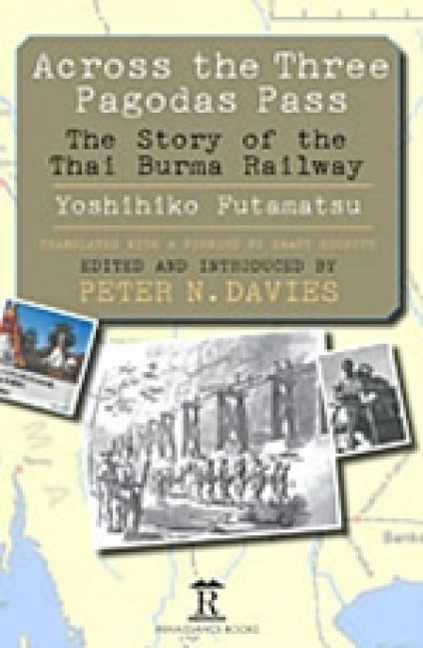Book contents
- Frontmatter
- Dedication
- Contents
- Acknowledgements
- Foreword
- Introduction
- Across the Three Pagodas Pass
- Translator’s Acknowledgements
- Preface
- Chapter 1 Departure for the Front
- Chapter 2 In Indo-China
- Chapter 3 Opening of Hostilities
- Chapter 4 The River Krian
- Chapter 5 The Malayan Campaign
- Chapter 6 The Fall of Singapore
- Chapter 7 Surrender
- Chapter 8 Shōnan: Light of the South
- Chapter 9 The Thai-Burma Railway
- Chapter 10 Preparing Construction
- Chapter 11 Banpong
- Chapter 12 Prisoners-of-War
- Chapter 13 Constructing the Railway
- Chapter 14 Thailand
- Chapter 15 The River Kwae Noi
- Chapter 16 The Mae Khlaung Bridge
- Chapter 17 Kanchanaburi
- Chapter 18 The Jungle
- Chapter 19 From Bangkok to Singapore
- Chapter 20 Rush Construction
- Chapter 21 The Base at Wanyai
- Chapter 22 The Labour Force
- Chapter 23 Survey Unit
- Chapter 24 Test Run
- Chapter 25 Bridge-Building and Shifting Earth
- Chapter 26 The Rainy Season: The Monsoon
- Chapter 27 Kinsaiyok
- Chapter 28 Diseases and Epidemics
- Chapter 29 Cattle Drive
- Chapter 30 Living in the Jungle
- Chapter 31 Soon to the Three Pagodas Pass
- Chapter 32 Towards the Setting Sun
- Chapter 33 Opening to Traffic
- Chapter 34 The Bombing
- Chapter 35 End of the War
- Chapter 36 Internment
- Chapter 37 Repatriation
- Footnote
- Postscript
- End Notes
- Glossary
- Bibliography
- Index
Chapter 16 - The Mae Khlaung Bridge
Published online by Cambridge University Press: 13 May 2022
- Frontmatter
- Dedication
- Contents
- Acknowledgements
- Foreword
- Introduction
- Across the Three Pagodas Pass
- Translator’s Acknowledgements
- Preface
- Chapter 1 Departure for the Front
- Chapter 2 In Indo-China
- Chapter 3 Opening of Hostilities
- Chapter 4 The River Krian
- Chapter 5 The Malayan Campaign
- Chapter 6 The Fall of Singapore
- Chapter 7 Surrender
- Chapter 8 Shōnan: Light of the South
- Chapter 9 The Thai-Burma Railway
- Chapter 10 Preparing Construction
- Chapter 11 Banpong
- Chapter 12 Prisoners-of-War
- Chapter 13 Constructing the Railway
- Chapter 14 Thailand
- Chapter 15 The River Kwae Noi
- Chapter 16 The Mae Khlaung Bridge
- Chapter 17 Kanchanaburi
- Chapter 18 The Jungle
- Chapter 19 From Bangkok to Singapore
- Chapter 20 Rush Construction
- Chapter 21 The Base at Wanyai
- Chapter 22 The Labour Force
- Chapter 23 Survey Unit
- Chapter 24 Test Run
- Chapter 25 Bridge-Building and Shifting Earth
- Chapter 26 The Rainy Season: The Monsoon
- Chapter 27 Kinsaiyok
- Chapter 28 Diseases and Epidemics
- Chapter 29 Cattle Drive
- Chapter 30 Living in the Jungle
- Chapter 31 Soon to the Three Pagodas Pass
- Chapter 32 Towards the Setting Sun
- Chapter 33 Opening to Traffic
- Chapter 34 The Bombing
- Chapter 35 End of the War
- Chapter 36 Internment
- Chapter 37 Repatriation
- Footnote
- Postscript
- End Notes
- Glossary
- Bibliography
- Index
Summary
The railway route in the Kanchancburi area ran from the crossing point over the River Mae Khlaung in the neighbourhood of Thā Makham near the tributary river, the Kwae Noi. The bridge at the present day on the Namtok Line is called the Kwae Noi bridge, but during the construction period it is correct that it achieved its fame as the ‘Mae Khlaung steel bridge’ (in Japanese it was called mekurongawa eikyū kyō, that is, ‘the permanent bridge over the Mae Khlaung’, to an engineer meaning a bridge with steel spans and concrete bridge-piers and bridge-abutments). As well as the steel bridge there was another, a wooden bridge, but that was prepared against flood times. The building of the steel bridge is now to be discussed (among prisoners-of-war it was called the Thā Makham bridge).
At the crossing at Thā Makham you had a river 300 metres wide with a water-surface of about 200 metres, and part of the crossing of the water-surface was the steel bridge with its steel trusses and concrete bridge-piers as a precaution against being flashed out by floods. The total length of the bridge was about 300 metres and over part of the water-course eleven spans of 20 metres each made the crossing. The wooden bridge was about 100 metres across with spans of five metres each. The big bridge was the only steel bridge on Thai-side and it was the longest bridge. In 1945 it was bombed and collapsed, but after the war it was repaired and is today's steel bridge on the Namtok Line.
After the war the film Bridge on the River Kwai (in Japan called ‘The Bridge Built in the Battlefield’) was based on the Frenchman Pierre Boulle's novel and together with the tune of ‘the River Kwai march’ (actually the military band piece called Colonel Bogey) spread throughout the world the story of the building of the Thai-Burma Railway and of the prisoners-of-war who were the labourers on it. There are many fabrications in the story-line which forms the background of the film and it did not transmit the truth.
- Type
- Chapter
- Information
- Across the Three Pagodas PassThe Story of the Thai-Burma Railway, pp. 76 - 81Publisher: Amsterdam University PressPrint publication year: 2013



